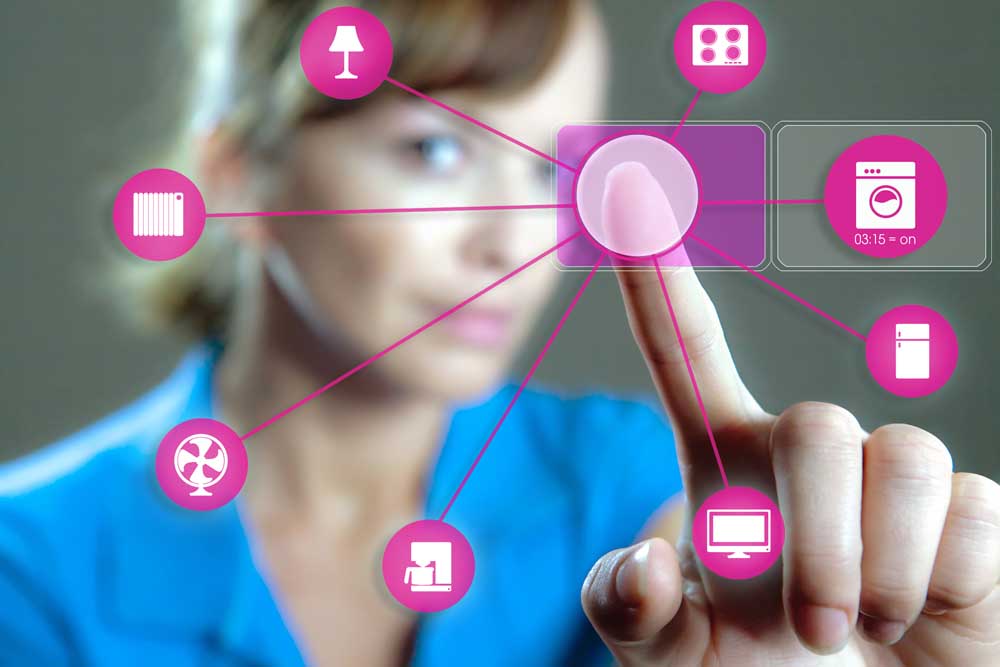Home evolution: The rise of the smart home
Published 12:00 am Saturday, January 19, 2019

- smart house device illustration with app icons
Thirty years ago, a porch light timer might have been considered smart home technology. Today, thermostats learn your desired temperature throughout the day and refrigerators can tell you when you need milk.
Central Oregon homes are becoming increasingly automated, and the emergence of smartphones paired with home automation systems has made turning on the porch light from the airport a reality. With perks formerly reserved for the Jetsons, homeowners can now control their thermostat from the office, preheat the oven while they’re still at the grocery store, and access thousands of recipes from a touchscreen display on the front of the fridge.
The term “smart home” refers to a residence that has appliances, HVAC, lighting, entertainment systems, security, and many more devices that communicate with one another. Such devices can be controlled remotely, and proponents of smart home technology say features can help people save money on utilities and conserve natural resources, all while providing peace of mind to homeowners.
Much to this writer’s amazement, there are smart kitchen suites that can scan a box of frozen pizza, display the cooking instructions on a touchscreen on the top of the range, preheat the oven, and set its timer. This same Whirlpool range also includes an “assist to cook” feature that not only gives you detailed recipes but adjusts temperature and cooking times automatically. For instance, if you have a meat dish that requires a high temperature at the start of cooking and a reduced temperature for the remainder, the oven can do that automatically. (Astro! Fetch my slippers! My work here is done.)
“A lot of manufacturers are realizing we’re not all gourmet chefs,” said Dave Johnson, general manager of Johnson Brothers Appliance in Bend. “They can give intelligence to the machines to help you do things better.”
And it gets even more cutting-edge. This month, as an addition to its smart appliance collection, Whirlpool launched a new feature that lets users scan food items around their kitchen with their phone (no barcode needed) and will then gather recipes based on those ingredients through its app, Yummly.
“You can scan a T-bone steak, a bag of potatoes, and a few carrots and it recognizes the food items and comes up with recipes,” said Johnson.
Say you’re at the store and you can’t remember if you need butter. Samsung has designed the Family Hub, a refrigerator that, in addition to a touchscreen display on the front, also has an interior camera that allows the user to “look” inside the fridge through their phone while wandering the aisles of the grocery store.
For multitaskers, using voice command technology can be a huge help. Need to preheat the oven but you’re busy in the laundry room? Pairing central hub voice command speakers like Amazon Echo or Apple Home Connect with a smart oven, you can give the voice command, “Turn on the oven to 350 degrees,” and abracadabra . . . It’s like having your own personal Rosie the Robot.
Smart home technology reaches way past the kitchen. From porch lights and window blinds to security systems and home entertainment, houses today can be automated from the broom closet to the mailbox.
Multiple smart home devices can run more smoothly if they all operate through one central computer brain. Achieving this sort of harmony sometimes requires a hub to consolidate the myriad of gadgets in your house. But not everyone needs a dedicated smart hub to make their setup run smoothly. Smart speakers can serve a similar purpose, with their respective apps acting as central command.
Advances in the industry have also made home entertainment just as good as going to a movie theater.
“Whole house audio is very popular right now,” said Jon Houston, sales manager for Stereo Planet in Bend.
“It’s made a resurgence with the introduction of streaming services like Pandora and players like Sonos and Bluesound. With streaming players, it’s really easy to pull out your phone or iPad and access pretty much any music you want and pump it through your entire house,” Houston said.
Since 1980, Stereo Planet has specialized in high-end custom sound systems and home theaters.
“Outdoor systems have become really popular. We do some really cool landscape systems using small aperture speakers with buried subwoofers in the backyard. It gives it a nice even sound all across the yard without having to turn it up really loud and blast your neighbors,” added Houston.
Surprisingly, the outdoor speakers can withstand High Desert winter weather and are designed to blend in with the landscaping (see photo, bottom right).
Houston explained that most people think everything in a smart home is wireless, but that is not the case with audio and video systems.
“We still wire a lot of houses,” said Houston. “It really is the best way to get the best quality sound.”
A smart home offers much more than just wireless control. It is a home with a system in place to integrate all the major components into an easy-to-use, reliable system, Houston explained.
“The smart home in the not-so-distant future will take this one step further and will automatically adjust the systems within it based on the optimal current environmental health needs of the homeowner,” he said. “Now that’s a truly smart home. Also very cool, if I might add.”
Houston went on to demonstrate technological advances in surround-sound systems in the store’s home theater room. As a video of firefly fairies played on the 135” screen, the room filled with the hum of thousands of fluttering wings. The sound, created by a Dolby Atmos system, was almost tangible.
“Audio used to be recorded to go from front to back and left to right. With Dolby Atmos, the sound has become very three-dimensional, using reflections and echoes and crisscrossing through the entire room,” he said.
Although there’s interest in smart home technology, the industry is still in the early stages and consumers are trying to figure out which devices are simply fun and which provide practical benefits.
“Smart appliances are still fairly new,” said Johnson. “They account for a small percentage of overall sales. There are still a lot of people who don’t feel they need these features, and to some, it falls into the gimmick category. Still, there are a lot of people who have built a smart home who are very interested in smart appliances. They want that ability to have the interface,” he said.
As technology marches onward, it will be exciting to see the possibilities that await us. But for now, we still have to take the frozen pizza out of the box ourselves.








